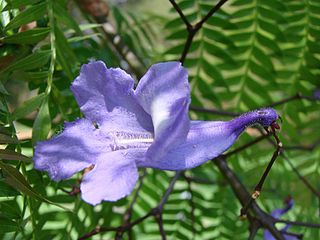
Amaryllis is the only genus in the subtribe Amaryllidinae. It is a small genus of flowering bulbs, with two species. The better known of the two, Amaryllis belladonna, is a native of the Western Cape region of South Africa, particularly the rocky southwest area between the Olifants River Valley and Knysna.

Jacaranda is a genus of 49 species of flowering plants in the family Bignoniaceae, native to tropical and subtropical regions of the Americas. The generic name is also used as the common name.

Dombeya is a flowering plant genus. Traditionally included in the family Sterculiaceae, it is included in the expanded Malvaceae in the APG and most subsequent systematics. These plants are known by a number of vernacular names which sometimes, misleadingly, allude to the superficial similarity of flowering Dombeya to pears or hydrangeas. Therefore, the genus as a whole is often simply called dombeyas. The generic name commemorates Joseph Dombey (1742–1794), a French botanist and explorer in South America, involved in the notorious "Dombey affair", embroiling scientists and governments of France, Spain, and Britain for more than two years.

Melhania is a genus of small shrubs or herbaceous plants. Traditionally included in the family Sterculiaceae, it is included in the expanded Malvaceae in the APG and most subsequent systematics. The genus is named for Mount Melhan in Yemen.
Melhania didyma is a plant in the mallow family Malvaceae, native to southern Africa.
Melhania integra is a plant in the mallow family Malvaceae, native to South Africa.
Melhania randii is a plant in the mallow family Malvaceae, native to southern Africa. It is named for the English doctor and plant collector R.F. Rand (1856–1937).
Melhania forbesii is a plant in the mallow family Malvaceae, native to southern Africa. It is named for the English naturalist and plant collector John Forbes.
Melhania polygama is a plant in the mallow family Malvaceae, native to South Africa.
Melhania rehmannii is a plant in the family Malvaceae, native to southern Africa. It is named for the Polish botanist and geographer Anton Rehmann.
Melhania transvaalensis is a plant in the family Malvaceae, native to South Africa.
Melhania burchellii is a plant in the family Malvaceae, native to southern Africa. It is named for the English explorer and naturalist William John Burchell.
Melhania damarana is a plant in the family Malvaceae, native to southern Africa.
Melhania suluensis is a plant in the family Malvaceae, native to southern Africa.
Melhania latibracteolata is a plant in the family Malvaceae, native to East Africa.

Melhania ovata is a plant in the family Malvaceae.
Melhania parviflora is a plant in the family Malvaceae, native to East Africa.
Melhania rotundata is a plant in the family Malvaceae, native to East Africa.
Melhania velutina is a plant in the family Malvaceae, native to Africa and the Arabian Peninsula.




